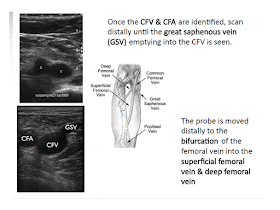SOURCE: Advanced imaging in
acute and chronic deep vein thrombosis, Gita Yashwantrao Karande , Sandeep
S. Hedgire , Yadiel Sanchez , Vinit Baliyan , Vishala Mishra , Suvranu
Ganguli , Anand M. Prabhakar © Cardiovascular Diagnosis and Therapy. Cardiovasc Diagn Ther 2016;6(6):493-507
DVT and Ultrasound (US)[extracted]
US is used in
evaluation of both symptomatic and asymptomatic DVT (patients at high risk of
DVT). It is useful not only in assessing DVT but can also identify other
conditions causing signs and symptoms indistinguishable from DVT.
Compression
US
Compression US has been procedure of choice for
investigation of suspected upper and lower extremity DVT for decades (14).
Other modification to this technique like two-point compression US (15),
extended compression US (16) and complete compression US (17) are used in
different combinations at different institutions.
Venous
duplex US
Lower extremity
venous duplex US combines 2 components to assess for DVT: B-mode or gray-scale
imaging with transducer compression maneuvers and Doppler evaluation consisting
of color-flow Doppler imaging and spectral Doppler waveform analysis.
Respiratory phasicity and cessation of flow with the valsalva maneuver offer
indirect evidence of patent abdominal and pelvic veins (18). The primary
diagnostic US criteria for acute DVT remains non-compressibility of the vein
with secondary diagnostic criteria being echogenic thrombus within the vein
lumen, venous distention, complete absence of spectral or color Doppler signal
within the vein lumen, loss of flow phasicity, and loss of response to valsalva
or augmentation (18). US can also be used to differentiate acute from chronic
thrombus. In acute thrombosis, vein is distended by hypoechoic thrombus and
shows partial or no compressibility without collaterals (Figure 1). In chronic
thrombosis, the vein is incompressible, narrow and irregular and shows
echogenic thrombus attached to the venous walls with development of collaterals
(Figure 2). According to American College of Radiology (ACR) guidelines and
technical standards, lower extremity US should include compression, color and
spectral Doppler sonography with assessment of phasicity and venous flow
augmentation (19,20). Advantages of lower extremity venous Duplex US are that
it is readily available, quick, cost effective, noninvasive, devoid of ionizing
radiation, lacks need for intravenous contrast and can be portable for
critically ill patients prone for developing DVT.
Limitations include that it is difficult and less
sensitive in patients with obesity, edema, tenderness, recent hip or knee
arthroplasty, cast, overlying bandages and immobilization devices. It also has
limitations in patients who had previous DVT and have new symptoms shortly
after the treatment. False-positive results include extrinsic compression of a
vein by a pelvic mass or other perivascular pathology (21) and thrombosis in
the distal popliteal vein. False-negative studies may occur in the presence of
calf DVT, proximal DVT in asymptomatic (even high-risk) patients or in the
presence of a thrombosed duplicated venous segment. In a systematic review of
accuracy of US in diagnosis of DVT in asymptomatic patients, Kassai et al.
suggested that US was accurate in proximal veins for diagnosis of DVT in
patients hospitalized for orthopaedic surgery (11) with lower sensitivity in
other settings.
Sonographic
elasticity imaging (SEI)
As described previously venous duplex US is considered primary
noninvasive imaging for DVT. However, this method cannot assess the age and
maturity of the thrombus i.e., it cannot distinguish pure post thrombotic
syndrome (PTS) (which develops in 20–50% of patients after DVT) from new
development of acute DVT with or without PTS (22). It is important to
distinguish acute on chronic DVT from PTS as the latter doesn’t require
anticoagulant therapy with highly potent fast acting anticoagulants associated
with high risk of bleeding (23). Also chronic clots are treated with oral
warfarin sodium, which has better safety profile than heparin. SEI is the
latest promising technique for estimating age of the thrombus. It uses tissue
deformation to assess the tissue hardness and hence clot maturity (24,25). It
has shown promising results in animals and in a few studies in humans. As SEI
requires tissue to be deformed during imaging, it is consistent with venous
duplex US which also requires compression. The degree of compression required
for standard strain measurements on SEI is lesser than compression US that is
beneficial for patients with swollen painful legs (26-28). Thus, even if
evaluation of clot age does not work, just the use of SEI to detect thrombi may
be an improvement over the present compression US technique. SEI can hence be
incorporated into standard duplex US so that thrombus can be diagnosed and
presumably aged simultaneously. SEI is in preliminary stages of investigations
and there is limited data on its ability to determine the age of DVT in human
subjects (26,29,30). It is highly operator dependent. Another limitation is
that comparison between the two clots requires an internal standard with the
same hardness in both images, as it is difficult to know the force that was
used to deform the tissue in each case. Rubin et al. used the wall of the vein
as standard but the hardness difference estimate was conservative due to lack
of another standard reference (31). Another limitation is that it is difficult
to distinguish between subacute and chronic thrombi that are closer in age (29).
….
Conclusions















Không có nhận xét nào:
Đăng nhận xét